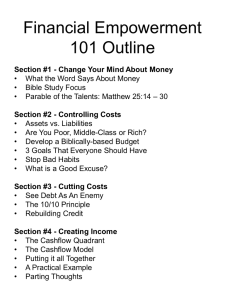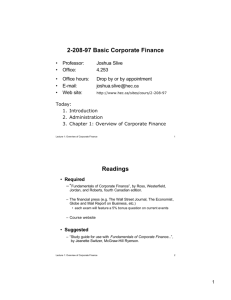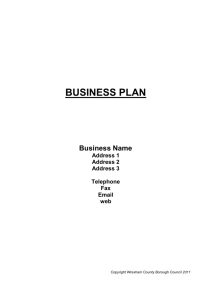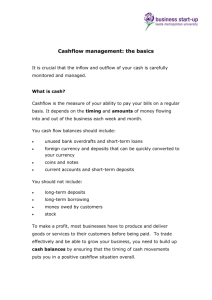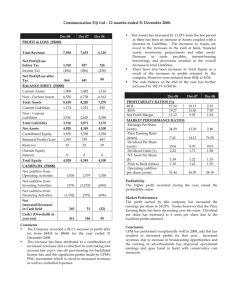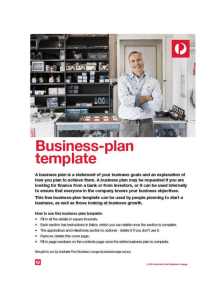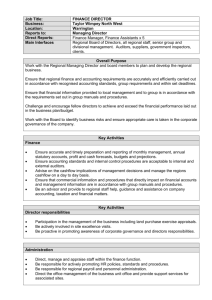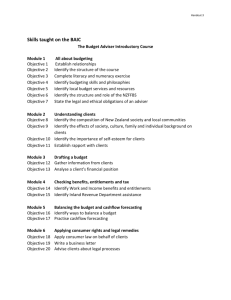Guide to Sessions 4-6 of Module 2: Client Selection
advertisement
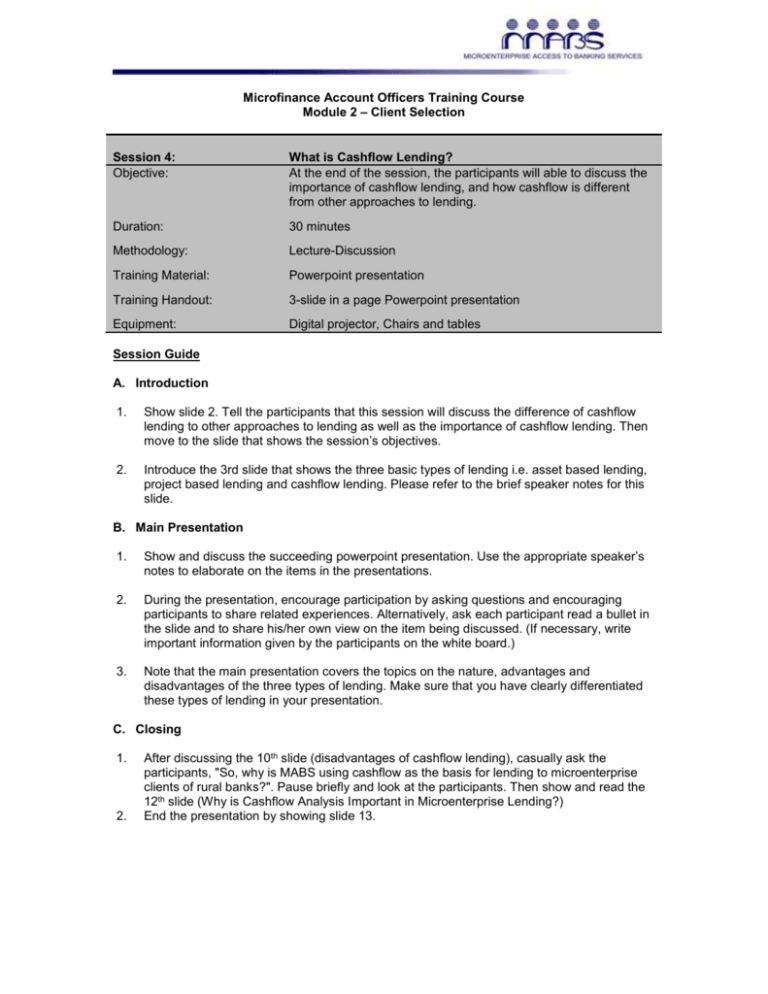
Microfinance Account Officers Training Course
Module 2 – Client Selection
Session 4:
Objective:
What is Cashflow Lending?
At the end of the session, the participants will able to discuss the
importance of cashflow lending, and how cashflow is different
from other approaches to lending.
Duration:
30 minutes
Methodology:
Lecture-Discussion
Training Material:
Powerpoint presentation
Training Handout:
3-slide in a page Powerpoint presentation
Equipment:
Digital projector, Chairs and tables
Session Guide
A. Introduction
1.
Show slide 2. Tell the participants that this session will discuss the difference of cashflow
lending to other approaches to lending as well as the importance of cashflow lending. Then
move to the slide that shows the session’s objectives.
2.
Introduce the 3rd slide that shows the three basic types of lending i.e. asset based lending,
project based lending and cashflow lending. Please refer to the brief speaker notes for this
slide.
B. Main Presentation
1.
Show and discuss the succeeding powerpoint presentation. Use the appropriate speaker’s
notes to elaborate on the items in the presentations.
2.
During the presentation, encourage participation by asking questions and encouraging
participants to share related experiences. Alternatively, ask each participant read a bullet in
the slide and to share his/her own view on the item being discussed. (If necessary, write
important information given by the participants on the white board.)
3.
Note that the main presentation covers the topics on the nature, advantages and
disadvantages of the three types of lending. Make sure that you have clearly differentiated
these types of lending in your presentation.
C. Closing
1.
2.
After discussing the 10th slide (disadvantages of cashflow lending), casually ask the
participants, "So, why is MABS using cashflow as the basis for lending to microenterprise
clients of rural banks?". Pause briefly and look at the participants. Then show and read the
12th slide (Why is Cashflow Analysis Important in Microenterprise Lending?)
End the presentation by showing slide 13.
Session 5:
Objective:
Preparing the Client's Cashflow
At the end of the session, the participants will be familiar with the
MABS Cash Flow Template and worksheets, know the basic
rules on preparing the cashflow, and analyze the debt capacity of
the borrower.
Duration:
4 hours
Methodology:
Lecture-Discussion and Exercises
Training Material:
Powerpoint presentation
Cash Flow Case Exercises
Cash Flow templates and worksheets
Training Handout:
3-slide in a page Powerpoint presentation, cashflow forms and
worksheets
Training Supplies:
Manila papers/pentel pens/white board markers
Equipment:
Digital projector, white board
Other requirements:
Calculators (one for each participant)
Session Guide:
A. Introduction
1.
Show the title slide. Explain that the topic on Preparing the Client's Cashflow presents the
step-by-step procedure in completing the MABS Cashflow Template. It shows in detail the
various component of the MABS Cashflow Template and how to fill-it up.
Then show the session’s objectives.
2.
Proceed with the 3rd slide by showing just the title "What is Borrower Cashflow Analysis"
and then ask the participants to give their opinions. Take note of the participants’ answers
And compare these with the slide containing the definition of borrower cashflow analysis.
Follow with the 4th slide to review the participants’ understanding of the importance of the
cash flow analysis.
3.
Discuss the 5th slide showing who is responsible for preparing the cash flow of the borrower.
B. Main Presentation
1.
After the 5th slide, distribute the copies of the MABS cashflow template as well as the
worksheets for retail and manufacturing enterprises. Follow this by showing the 6th and 7th
slides which basically contain the template and its major components.
2.
The 8th up to the 10th slides discuss the basic rules in preparing the cash flow. Make sure
that the participants get a clear understanding of this portion of the presentation.
3.
Slides 11th to 50th discuss step-by-step how the cash flow worksheets and main cash flow
forms are accomplished.
Session Guides: Cashflow Modules
2 of 7
4.
In case the participants ask about the denominator of the cashflow formula, explain how the
denominator in the cashflow formula is derived using the reference given in the participants’
kit.
5.
Use the following explanations on how to use the worksheets and its importance to the
computation of the cash flow. The worksheets illustrate the income and expenses incurred
by the enterprise as reflected in the sales and purchases worksheets.
Worksheet 1.a: Sales Worksheet
a. Get the average sales of the applicant's business. If the applicant is operating more
than one retail enterprise (for example, a sari-sari store and buy and sell of fruits), write
the daily sales of each type of enterprise in columns for business 1 and 2 respectively.
b. Get the average sales by adding the sales from Monday to Sunday and then divide the
sum by 7 (for 7 days). Copy the average sales from the worksheet to the daily column
of the income from the business in the cashflow form.
c. For enterprises operating less than five days in a week, get the sum of the sales and
then copy it to the to the weekly column of the appropriate business.
Worksheet 1.c: (Raw Materials Purchases)
d. Under the first column, identify at least five sellable products of the enterprise with their
appropriate wholesale costs or purchase price (column 2), the quantity or volume being
purchased (column 3).
e. In column 4, write the item cost for each product by dividing the wholesale costs by the
quantity purchased.
f. Write the selling price of each product in column 5.
g. Compute for the price mark-up of the enterprise by using the following formula:
{(Sum of Selling Price Sum of Item Costs) - 1} x 100
For example:
Sum of items costs is P75
Sum of selling price is P90
Price Mark-Up = {(P90 P75) - 1} x 100 = 20%
h. The computation of the price mark-up is needed to derive the realistic amount of
purchases of the enterprise. There are instances that applicants cannot remember the
amount of their purchases and may tend to lower their purchases and increase their
sales resulting to a higher income and subsequently higher loan amount.
Session Guides: Cashflow Modules
3 of 7
Costs of Purchases
i.
Get the average daily sales and price mark-up that you computed in worksheet 1.a and
1.c respectively.
j.
Compute for the purchase costs of the enterprise using the following formula:
Purchase Cost = (Average Daily Sales) (1+Price Mark-up)
k.
Copy the result to the daily column of the raw materials purchases of the appropriate
business. If the sales computed are based on a weekly basis put the cost of purchases
in the weekly column.
l.
In case participants will ask on how the formula for purchase cost was derived
particularly the denominator, you can use the following explanation.
-
The formula for purchase costs is derived from the original formula of the price
mark-up which is:
Price Mark-Up = Selling Price - Purchases
Purchases
Where: M is Price Mark-up; S is Selling Price; P is Purchases
Thus, the abbreviated formula: M = S-P
p
-
Expanding the equation: M = S - P
P P
-
Solving for the fraction: M = S -1
P
-
Transposing 1: M+1 = S
P
-
Canceling similar terms: P(M+1) = S
-
Solving for P: P(M+1) = (S)
(M+1)
(M+1)
-
Purchase Cost Formula: P = S (M+1)
AOs Notes
j.
k.
This area serves as the scratch area of the AOs in the computation of the items in
worksheets 1 and 2. For example, the AO can indicate the composition of the sales of
the applicant. Whether part of the applicant's sale is based on consignment basis or
based on credit thus the reason why on some days her sales is higher while in other
days her sales is lower as shown in worksheet 1.
The AO can also note here the details of the expenses of the applicant's enterprise.
Session Guides: Cashflow Modules
4 of 7
Worksheet 1.b: Cost computation for Processing & Manufacturing Enterprises
a. There are four columns in worksheet 2 namely raw materials, cost per unit of
measurement, # of units of purchased and amount of purchased. Classify the raw
materials or purchases by daily, weekly or monthly.
b. Get the total amount of purchases or raw materials.
c. Copy the total amount of purchases or raw materials to the appropriate column on the
cashflow form under raw materials purchases of the business expense section.
C. Closing
1.
Review the salient points discussed in your presentation. Emphasize the following points:
a. Always remember the basic rules in preparing the cashflow: First, the cashflow should
be based on the applicant's present income. Second, the cashflow should only include
the applicant's regular income and expenditures. Third, All entries should be recorded in
their appropriate columns.
b. The mode of loan payment should be based on the column where his/her income is
high enough to accommodate the loan payments. However, MABS strongly
recommends a weekly mode of loan payment since this facilitates account officer’s
productivity and cost-efficiency.
2.
After this session, proceed to solving the case studies.
Session Guides: Cashflow Modules
5 of 7
Session 6:
Objective:
Cash Flow Review Techniques
At the end of the session, the participants should know the
techniques on how to review the cashflow of the applicants.
Duration:
2 hours (1.5 hours for discussion & .5 hour for case exercise)
Methodology:
Lecture-Discussion, Case Analysis
Training Material:
Powerpoint presentation
Cash Flow Case Exercise-Jennifer Delima’s Bakery
Training Handout:
3-slide in a page Powerpoint presentation
Training Supplies:
Manila papers/pentel pens/white board markers
Equipment:
Digital projector, white board, chairs and tables
Other Requirements:
Calculators (one for each participant)
Session Guide:
After the case analysis, present the topic on Cashflow Review Techniques. This topic
analyzes whether the information provided by the applicant in his/her cashflow is realistic or
not. This can be done by looking at the 5 indicators in the clients cashflow: (1) price markup or profit margin, (2) normal inventory, (3) total monthly income from business and other
sources, (4) total monthly household expenses, and (5) net monthly income.
A. Introduction
1.
Show the title slide "Cashflow Review Techniques". Tell the participants that in this
session, they will learn how to analyze certain components of the prepared cashflow to be
able to establish the accuracy and consistency of the data used in its preparation.
Then proceed to next slide which discusses the session’s objectives.
2.
Present the 3rd slide. This slide explains why there is a need for the participants to learn
about cashflow review techniques. The first bullet indicates that the AOs rely on the verbal
informations supplied to them by the applicant since most microenterprise operators do not
keep records of their business. The second bullet supports this observation by concluding
that as a result the applicant either overstate their income or understate their expenses
which would enable them to avail of a bigger loan. These errors in the declaration of the
client's cashflow, if not detected and reviewed properly, could lead to delinquency later on.
3.
The 4th slide presents the outline of the review techniques that will be discussed in details.
B. Main Presentation
1.
Discuss each indicator thoroughly with the participants i.e. price mark-up or profit margin,
normal inventory, total monthly income from business and other sources, total monthly
household expenses and net monthly income.
Session Guides: Cashflow Modules
6 of 7
2.
Make sure that the formulas contained in the appropriate indicators are discussed
thoroughly with the participants. And how they relate to the analysis of the cashflow.
C. Closing
1.
End the session by stressing the following: "The MABS Approach always presents ways to
help its participating banks mitigate the risks in lending to microenterprise clients. The
cashflow review techniques enable banks to adopt a more conservative approach to
microenterprise lending. Using these techniques will reduce errors on overestimating the
credit capacity of the clients.
2.
Afterwards, instruct the participants to retrieve the cash flow computation they did for the
Jennifer Delima Bakery cash flow exercise. Ask the participants what error did they notice
or observe in the cash flow computation of Jennifer Delima. Ask the participants to recompute the cash flow of Jennifer Delima to correct the error in the computation.
Session Guides: Cashflow Modules
7 of 7
